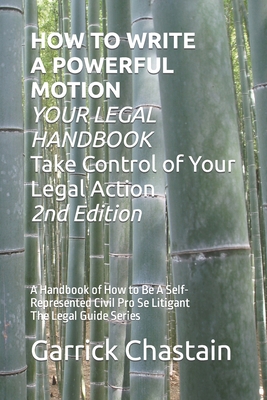You are here
Back to topHOW TO WRITE A POWERFUL MOTION YOUR LEGAL HANDBOOK Take Control of Your Legal Action: A Handbook of How to Be A Civil Pro Se Litigant 102 Second of Th (Paperback)
$9.45
Usually Ships in 1-5 Days
Description
We all know that "motion" is a physical change in position. Similarly, in legal sense, A Motion is a procedural act in the legal proceeding that a party, either the plaintiff or the defendant, makes a request to the court to do something. Very much like playing a chess game or baseball game that there are rules allowing each party to make the next step to proceed further. You have options strategically which next step to proceed further. Sometimes, uninvolved third parties may file motions to participate the legal pursuit, such as Motion to Intervene if that third party has interest in the controversy as of right.
During the legal proceeding, there are certain motions have time limitations sequentially. For instance, before the defendant answers/pleas the complaint, if he/she/it does not file a motion to request to revise the complaint based on legal defect and/or insufficiency i] within certain time frame, he/she/it loses the right to request to revise the complaint unless the plaintiff amends (changes or modifies) the complaint down the road in the proceeding. If the plaintiff needs to amend the complaint, he/she/it must file a motion requesting the court's permission to do so, Motion to Leave to Amend Complaint. Sometimes, during a litigation, the plaintiff may need to amend the complaint multiple times; and, if the defendant files a Counter-Complaint, he/she/it can amend the counter-complaint by filing a motion requesting the court's permission to do so. Of course, the opponent may file objection to the moving party' motion. A special note that, in most of the jurisdictions, the plaintiff can amend the complaint within the first 30 days from filing the complaint. You should always check the practice rules of the jurisdiction where you intend to file your complaint. Practice rules are statutory, you should be able to access to the types of motion available on internet involving a litigation in any particular jurisdiction. After you file a motion, your opponent is allowed certain time limitation to reply to your motion in opposition/objection; you, then, have some limited time to respond/reply/rebut your opponent's objection. If your opponent wishes to rebut or to dispute your reply to his/her/its objection/opposition, he/she/it should file a "Motion for Leave to File Surreply". This type of procedural rules is the same in both Federal and state jurisdictions. Each state has her judicial litigant practice rules from the statutes. In some jurisdictions, party may be allowed to "supplement" additional filings to the motion/objection/reply already filed to submit additional relevant materials. Before you initiate a legal action or after receiving a Summons of being sued, it is essential to have access to the rules as reference whether you are represented by an attorney or by yourself. There are arguable and non-arguable motions, for which we will discuss more later in this eBook. Although all motions are important, certain arguable motions can be makers or breakers. For instance, no party should take Motion to Dismiss and Motion for Summary Judgment (arguable motions) lightly. If judge grants the defendant's motion to dismiss (MTD) or the defendant's motion for summary judgment (MSJ), your case is over. However, you may file a motion for permission to amend your complaint to rephrase your allegation (Motion to Leave to Amend Complaint.), or a motion for reconsideration of judge's ruling to keep your case alive.
